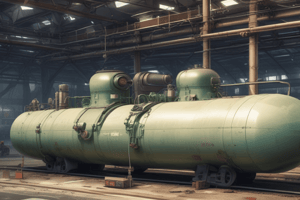Podcast
Questions and Answers
What is a Low-Pressure Area (LPA)?
What is a Low-Pressure Area (LPA)?
- A region with lower pressure than its surroundings (correct)
- A type of tropical cyclone with no rain
- A storm characterized by high temperatures
- A specific type of weather front
Which of the following statements correctly describes the formation of an LPA?
Which of the following statements correctly describes the formation of an LPA?
- Wind spreads across the ocean surface evenly
- Cold air sinks and creates high pressure
- Warm evaporation rises, creating a low pressure below (correct)
- Rainfall leads to the lowering of atmospheric pressure
What is one common characteristic of tropical cyclones?
What is one common characteristic of tropical cyclones?
- They have a consistent wind speed preventing damage
- They only form during winter months
- They occur primarily over land
- They are characterized by heavy rainfall and high sea waves (correct)
What typically happens when a tropical cyclone moves inland?
What typically happens when a tropical cyclone moves inland?
Why does PAGASA categorize cyclones based on their wind speed?
Why does PAGASA categorize cyclones based on their wind speed?
Which of the following is NOT a hydrometeorological hazard?
Which of the following is NOT a hydrometeorological hazard?
What should local government units (LGUs) do before a cyclone hits?
What should local government units (LGUs) do before a cyclone hits?
How can families prepare for an incoming tropical cyclone?
How can families prepare for an incoming tropical cyclone?
What role do geologists, meteorologists, and local officials play during tropical cyclones?
What role do geologists, meteorologists, and local officials play during tropical cyclones?
What is a secondary hazard caused by tropical cyclones?
What is a secondary hazard caused by tropical cyclones?
What is a significant effect of flooding on communities?
What is a significant effect of flooding on communities?
What is a recommended safety measure during floods?
What is a recommended safety measure during floods?
What phenomenon accompanies powerful sea waves during a tropical cyclone?
What phenomenon accompanies powerful sea waves during a tropical cyclone?
What was a significant consequence of Super Typhoon Yolanda in 2013?
What was a significant consequence of Super Typhoon Yolanda in 2013?
Which of the following can increase the likelihood of flooding in urban areas?
Which of the following can increase the likelihood of flooding in urban areas?
How are areas marked according to their flooding hazards?
How are areas marked according to their flooding hazards?
Flashcards are hidden until you start studying
Study Notes
Low-Pressure Areas (LPA)
- LPA is a region with lower atmospheric pressure compared to surrounding areas.
- LPAs are often precursors to tropical cyclones and typhoons.
- Meteorologists use pressure drops to forecast weather changes.
Formation of LPAs
- Warm evaporation from ocean waters rises, creating low pressure below.
- Vapor thickens into clouds which are moved by storm winds.
- Clouds condense and precipitate as rain.
- Gases move from high-pressure areas (HPA) to LPA, forming winds.
Hydrometeorological Hazards
- These are natural atmospheric or oceanic processes that can lead to loss of life or damage.
- Hazards include tropical cyclones, floods, and storm surges.
Tropical Cyclones
- Large storms characterized by a low-pressure area and powerful winds.
- They gain strength over bodies of water and weaken when moving inland.
- Areas hit by cyclones experience strong winds, heavy rainfall, and high sea waves.
Destructive Effects of Cyclones
- Strong winds can damage structures, vehicles, and topple trees.
- High-speed winds can capsize vessels and project dangerous debris.
- PAGASA categorizes cyclones based on wind speed for public safety.
Preparedness for Cyclones
- Regular occurrences have made Filipinos adept at cyclone preparation.
- Pre-cyclone measures include securing tree branches, reinforcing roofs, and boarding windows.
- Local Government Units (LGUs) must identify at-risk communities prior to storms.
Flooding as a Secondary Hazard
- Heavy rainfall from cyclones leads to flooding, which can be gradual or sudden (flash floods).
- Flooding areas are categorized based on potential floodwater heights: low (up to 0.5 m), moderate (up to 1.0 m), and high (above 1.0 m).
- Low-lying areas serve as basins for floodwater, increasing vulnerability.
Impact of Flooding
- Flooding can result in structural damage and physical hazards, leading to biological risks.
- Historical floods have caused outbreaks of diseases like leptospirosis.
- Local governments are encouraged to invest in flood prevention measures, including floodgates and adequate drainage systems.
Storm Surges
- A storm surge arises from rising sea levels and powerful waves during a tropical cyclone.
- Strong winds push coastal waters, amplifying wave heights, posing risks to coastal communities.
- The catastrophic effect of Super Typhoon Yolanda in 2013 exemplified the deadly nature of storm surges, causing extensive destruction in Tacloban with waves up to 7 meters high.
Studying That Suits You
Use AI to generate personalized quizzes and flashcards to suit your learning preferences.




